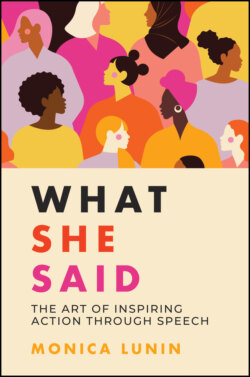Читать книгу What She Said - Monica Lunin - Страница 24
2 Sharing complex thoughts and ideas
Оглавление
Your expertise has no value to the world if it cannot be understood.
For your ideas to take hold, inspire others and create change, they must be transmitted. There is so much opportunity for confusion. Your audience will get confused if they don't understand the terms you're using or don't have the background knowledge required to appreciate the concepts. Even experts can become confused when delivering information because they have so much detail in their heads and a particularly deep understanding of their own field that they don't know where to start. Sometimes they jump around in their delivery, trying to fill in gaps, and then become overwhelmed or discouraged because their audience is just not getting it.
When planning a speech or presentation where you need to share complex ideas, first consider why the audience needs to know what you have to share. Decide on the most important benefit for them and then clarify their current level of understanding. In a broad sense, your job is to break down your concepts into their component parts and communicate each part in a manner that can be understood. You will need to make things as simple as possible, but no simpler. Before you craft your speech or presentation think about the audience, and then work out how to bridge the gap from the known to the unknown.
The speeches in this chapter are examples of women who have bridged this gap. Many of us have enjoyed learning about new concepts from the TED stage. Beginning in 1984 as a conference where Technology, Entertainment and Design converged, this lecture series now covers almost all topics — with the ambitious goal of lifting awareness in an age of reduced attention spans. Brené Brown's TED Talk on ‘The power of vulnerability' is a master example of deep expertise made accessible to the mass market. Part of the secret here is to put yourself in the story. Brown takes the audience with her on her own journey of exploration and discovery. Who knew social science research could be so life-changing?
Sometimes your ideas will disrupt the status quo. Like philosopher Hannah Arendt, you may have an insight that is complex, potentially confusing, but ultimately necessary in advancing our understanding of the human condition. In this case, you have all the more reason to speak up. The world of academia would have you believe that you, as an individual, have no place in the research and that you need to anonymise your findings. You can challenge that paradigm if you want to transmit more than your knowledge, if you want to help people see why it matters.
Perhaps communicating to a general audience is a challenge for you. Marie Curie was a practised teacher, but she preferred to lecture students in chemistry and physics — an audience already equipped with a foundation of knowledge upon which she could build. Delivering a Nobel Lecture to a general audience upon the acceptance of her second Nobel Prize was a challenge. Her example reminds us to define any terms that may be ambiguous and to signpost the information to make sure nothing is lost. The world now has the cherished gift of Dr Curie explaining the significance of the discovery of radium in her own words.
You might be driven by your own curiosity about a topic or a personal quest for understanding. Margaret Atwood first started looking at the topic that would become the focus of her Massey Lecture Series ‘Payback' for her own edification — that is, she wanted to understand the concept of debt and the shadow side of wealth. Her research began with the goal of enhancing her own knowledge, and then grew into a five-part lecture series. There is no better way to learn a concept, inside and out, than to teach it. You will likely see, as Atwood did, that an overwhelming amount of information needs to be broken down into categories, and then further reduced into bite-sized chunks. Atwood brings her superior literary capability to the lectern by sharing anecdotes and retelling ancient stories to help the audience understand complex ideas.
